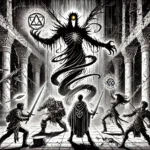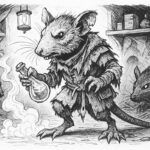
In the realm of Dungeon Mastering, crafting a captivating dungeon is an art form. We meticulously design maps, populate them with intriguing encounters, and scatter coveted loot. Yet, players can sometimes navigate these meticulously planned labyrinths with an almost spectral ease. The missing ingredient? The spark of life.
A truly immersive dungeon isn’t just a backdrop for combat; it’s a living, breathing entity. Here, we’ll delve into strategies for infusing your dungeons with dynamism, transforming them from static environments into captivating narratives where the very surroundings become active participants.
A World in Flux
Transient Tenants: Imagine the party encountering another adventuring group, fresh from a skirmish or laden with spoils. Did this previous group leave evidence of success, like cleared rooms and valuable intel? Or perhaps a gruesome demise serves as a chilling cautionary tale? These encounters weave a richer tapestry, hinting at past events and shaping the party’s future.
Migratory Monsters: Creatures within shouldn’t be stagnant. Perhaps a pack of hungry dire wolves roams the caverns, their location dictated by prey availability or the party’s actions. Imagine the wolves drawn by the sounds of combat, forcing the party to adapt their strategy mid-fight. This uncertainty keeps players on their toes, the next encounter a constant dance with the unknown.
The Circle of Hunger: Dungeons can be breeding grounds for a complex food chain. Introduce a predator-prey dynamic. Imagine goblins who hunt giant rats to survive, while giant spiders, in turn, prey on both goblins and rats. This creates a web of tension and survival. The party might choose to exploit this dynamic by luring the spiders towards the goblins, or use the distraction to bypass the spider’s territory altogether. Perhaps the party encounters the aftermath of a gruesome battle between goblins and spiders, littered with gnawed bones and discarded weapons. This not only hints at the dangers within, but also offers a strategic opportunity for the party to navigate the dungeon.
Clash of the Titans: Dungeons can be battlegrounds for territorial disputes. Imagine orcs and undead locked in a brutal brawl, forcing the party to navigate the chaos or exploit the situation for strategic gain. Perhaps the party can weaken both sides before striking a decisive blow, or they might use the commotion to slip past unnoticed.
A Living, Breathing Environment
- Environmental Hazards: Danger isn’t limited to monsters. The dungeon itself can pose a threat. A rickety bridge sways precariously underfoot, a sudden tremor triggers a cave-in, or noxious fumes waft from a hidden volcanic vent. These hazards add an extra layer of tension and reward creative problem-solving. Imagine the party desperately clinging to the bridge as it crumbles, or using magical winds to disperse the toxic fumes before they succumb.
- Weather Within: Imagine a subterranean lake churning with a magical storm, its electrical discharges crackling through the air, or a vast cavern with shifting air currents that push and pull at the party, making ranged attacks a gamble. Weather effects within the dungeon create dynamic challenges and force players to adapt their tactics on the fly.
- The Shifting Sands of Time: Perhaps certain areas of the dungeon change over time. A magical gate opens and closes at specific intervals, revealing hidden dangers or shortcuts. A section of the floor might transform from solid stone to perilous quicksand after a specific weight limit is reached, forcing the party to find alternate routes. This sense of impermanence keeps players engaged and encourages them to think outside the box.
Making it Real
- Telegraphing Change: Don’t leave your players completely surprised. Subtle clues – tracks, discarded items, tremors, or shifting air currents – can hint at the presence of other creatures, impending environmental hazards, or the existence of time-based challenges. This allows players to make informed decisions without feeling unfairly ambushed.
- Consequences and Rewards: The players’ actions should have a ripple effect. If they trigger a cave-in, they might need to find a new way forward, or their actions could create a shortcut for future adventurers. Conversely, defeating a territorial predator might open up a previously blocked passage, revealing new loot or story elements. This reinforces the idea that the dungeon is a living entity, reacting to their choices.
- Embrace the Unexpected: Don’t be afraid to throw curveballs at your players. A sudden influx of water might force them to abandon a planned route, or a collapsing bridge might create a desperate scramble for survival. These unexpected moments keep the players engaged and highlight the ever-evolving nature of their environment. Imagine the party forced to use a raft to navigate a flooded corridor or clinging desperately to a crumbling ledge, their creativity and teamwork the only things standing between them and a watery grave.
Let the Dungeon Breathe!
By breathing life into your dungeons, you transform them from mere backdrops into captivating narratives. Your players will become active participants in a living world, forced to adapt their strategies and confront the ever-changing environment. So, go forth, fellow Dungeon Masters, and weave your magic! Craft dungeons that are more than just maps and monsters; create living, breathing ecosystems that will leave your players breathless.
Have you experimented with dynamic dungeons in your campaigns? How did your players react? Share your experiences and creative ideas in the comments below! Let’s swap stories and inspire each other to craft truly unforgettable adventures.
Discover more from Cresthaven RPG
Subscribe to get the latest posts sent to your email.








